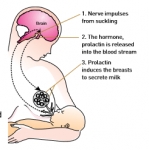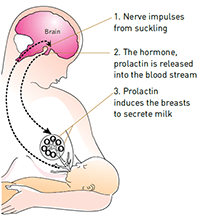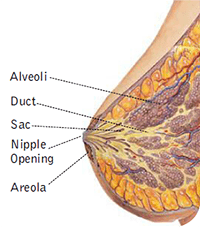A Guide to Successful Breastfeeding

6 - 8 times in a day. This usually means that the feed is sufficient. If in doubt, ask the advice of your paediatrician.
A baby check and a satisfactory weight record may reassure you.
How often should I breast feed?
It is best to follow your baby’s pattern and feed on demand. Human milk is digested more easily than formula, and breast fed babies are likely to be hungry earlier. Try to empty one breast completely as the last part of the milk has a lot of fat which helps a baby to remain satisfied and contented for longer.
most of the areola (the dark, coloured part of the breast around the nipple) into its mouth. The baby’s lips should be spread outwards, and the pressure of the baby’s gums should be on the areola and not on the nipple.
Every time my baby latches on I get pain - what should I do?
The first few days of breast feeding is a learning process. If your baby latches only on to the nipple rather than the areola, it can produce a lot of pain. Proper latching-on advice can prevent cracked nipples. In case of cracked or bleeding nipples, early intervention by your obstetrician will help.
If I go out how can I breast feed?
Major shopping centres have rooms for feeding & changing. If such facilities are not available, expression of breast milk and feeding expressed milk is the next best option. Expressed milk can stay out for 6 hours at room temperature, for 1 week in the refrigerator and for 3 months in the freezer. To thaw out the milk, put in a bowl of lukewarm (NOT HOT) water.
I get very tired breast feeding throughout the day - how can I breast feed at nights?
The important rule in breast feeding is to be comfortable. A comfortable mother means a relaxed baby. At night when you are most tired, find the most comfortable position for both you and the baby. Feeding expressed milk (see overleaf) could be an option, though for the first few weeks it is better to encourage your baby to suck day and night, to encourage milk flow. The more times you feed, more the milk flows.
My baby feeds all the time, sometimes for hours at a stretch - it makes me very tired - what should I do?
The important part is to ensure that the baby is latched on correctly & positioned comfortably. If in doubt, seek the advice of an older, experienced member of the family. If still in doubt, you can contact the hospital or a breast feeding support group. In the first week after delivery, it may take some time for both mother & baby to settle in to the feeding routine. Please be patient with your baby.
I am not sure that my baby is getting enough milk. How would I know?
If a baby settles after a feed, it usually means he is getting enough. Normally, a breast fed baby will pass urine 6 - 8 times in a day. This usually means that the feed is sufficient. If in doubt, ask the advice of your paediatrician. A baby heck and a satisfactory weight record may reassure you.
How often should I breast feed?
It is best to follow your baby’s pattern and feed on demand. Human milk is digested more easily than formula, and breast fed babies are likely to be hungry earlier. Try to empty one breast completely as the last part of the milk has a lot of fat which helps a baby to remain satisfied and contented for longer.
Breast is best
Breast milk is the best food for your baby. Your body produces it naturally and it contains just the right blend of protein, sugar and fat. It is always available at the right temperature and requires no special preparation. It changes as the baby grows. It provides, in most cases, all the nutrition a full term baby needs for the first six months. During breast feeding, it is best to offer the other breast only after the baby has finished the first, although it is perfectly normal to be satisfied with only a single breast per feed. Just make sure you alternate breasts from one feed to the next. This is important as the milk changes in quality throughout feeding the first milk (fore milk) contains more sugar and water to quench thirst while the last part (hind milk) provides fat for energy and to satisfy hunger.
What happens during breast feeding?
When a baby suckles, signals are sent from the breast to the brain. There, a hormone called prolactin, is released into the blood. This acts on the breast to make it secrete milk. So, the more the baby sucks, the more the stimulation for milk.

COMMONLY ASKED QUESTIONS
Why should I breast feed my baby?.
What are the advantages it has for me and the baby? Breast milk contains protection against many illnesses in the baby - most importantly, chest and stomach infections. There is strong evidence to show that it decreases the risk of allergies. Breast milk has contents which help the best growth of the baby’s body & brain. Even better – mothers produce protection to infections in the environment, making the milk extra strength to help the baby fight illnesses.

For the mother - it is less tiring cleaner, safer with no preparation of bottles. It may be easier to lose weight as lactation burns up extra calories. Breast feeding helps bonding with your baby. Also, research shows that the risk of breast cancer may be reduced.
Does the size of my breasts affect how much milk I produce?
No, it does not matter. The size of the breast changes depending on the amount of fatty tissue there is in the breast but the number of milk glands is generally the same in all women.
Is there any particular posture to be adopted during feeding the baby?
Instead of bending herself, the mother should bring the baby to her breast. Latching of the baby to the breast is very important. The baby should take not just the nipple, but also most of the areola (the dark, coloured part of the breast around the nipple) into its mouth. The baby’s lips should be spread outwards, and the pressure of the baby’s gums should be on the areola and not on the nipple.
Every time my baby latches on I get pain - what should I do?
The first few days of breast feeding is a learning process. If your baby latches only on to the nipple rather than the areola, it can produce a lot of pain. Proper latching-on advice can prevent cracked nipples. In case of cracked or bleeding nipples, early intervention by your obstetrician will help.
If I go out how can I breast feed?
Major shopping centres have rooms for feeding & changing. If such facilities are not available, expression of breast milk and feeding expressed milk is the next best option. Expressed milk can stay out for 6 hours at room temperature, for 1 week in the refrigerator and for 3 months in the freezer. To thaw out the milk, put in a bowl of lukewarm (NOT HOT) water.
I get very tired breast feeding throughout the day - how can I breast feed at nights?
The important rule in breast feeding is to be comfortable. A comfortable mother means a relaxed baby. At night when you are most tired, find the most comfortable position for both you and the baby. Feeding expressed milk could be an option, though for the first few weeks it is better to encourage your baby to suck day and night, to encourage milk flow. The more times you feed, more the milk flows.

My baby feeds all the time, sometimes for hours at a stretch - it makes me very tired - what should I do?
The important part is to ensure that the baby is latched on correctly & positioned comfortably. If in doubt, seek the advice of an older, experienced member of the family. If still in doubt, you can contact the hospital or a breast feeding support group. In the first week after delivery, it may take some time for both mother & baby to settle in to the feeding routine. Please be patient with your baby.
I am not sure that my baby is getting enough milk. How would I know?
If a baby settles after a feed, it usually means he is getting enough. Normally, a breast fed baby will pass urine



